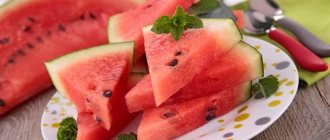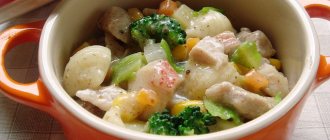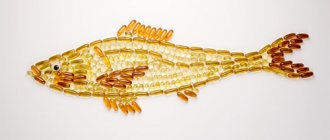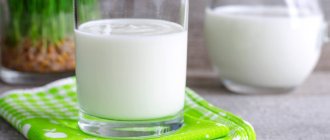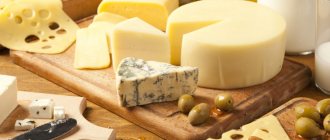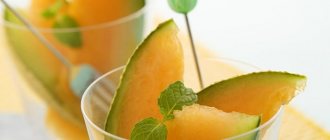They say that a woman's diet changes after childbirth. In fact, this happens even during pregnancy. It’s just that after giving birth, the way the baby eats changes. This does not mean: the baby is born, the mother is free, you can eat whatever you want. Everything that the mother eats, the baby eats. Accordingly, during this period, experts pay special attention to the mother’s nutrition. The diet should consist of products that will not harm the baby, will not cause any allergic reactions, and at the same time will be varied, healthy and rich in all necessary components. Dairy products, cottage cheese in particular, occupy a leading place in replenishing the body with the components necessary for breastfeeding, including calcium.
What are the benefits of cottage cheese?
Why cottage cheese is needed will become clear when we decide why it is useful. It has been used for hundreds of years. Since people domesticated animals and began to receive milk from them. This product contains:
- Vitamins A, E, C, PP, B.
- Calcium – helps strengthen bones, improves the condition of nails and hair. Affects blood clotting.
- Potassium is responsible for the functioning of the circulatory system.
- Magnesium – regulates metabolism in the body, helps restore strength.
- Iron is responsible for the oxygen supply to all tissues, including the brain. Normalizes the functioning of the thyroid gland.
- Copper – ensures the functioning of the nervous system, improves the body’s protective functions.
- Phosphorus – helps improve memory, is responsible for the formation of the skeletal system.
- Fluoride – improves the condition of tooth enamel, reduces the risk of osteoporosis.
- Zinc – promotes cell regeneration and strengthens the immune system.
Constant consumption contributes to:
- Replenishing the mother’s body, which works for two, with the necessary components.
- Full development of the baby, his growth, balanced formation of the skeleton.
- Development and strengthening of muscle tissue.
- Normal functioning of brain activity, quality of memory.
- Improves liver function and bile release.
- Ensuring good appearance of hair, nails, skin, teeth, both for mother and baby.
- Promotes lactation.
In what cases is cottage cheese contraindicated?
The main rule: the product must be fresh! Since cottage cheese is a perishable product, consumption with a questionable expiration date can cause poisoning and negatively affect the baby.
Contraindication for use is intolerance to the protein contained in cow's milk. It can cause allergic and other manifestations in the form of:
- skin rashes;
- diarrhea;
- constipation;
- colic and spasms;
- regurgitation.
The fact is that the human immune system recognizes cow protein as a foreign substance and a protective reaction occurs. This reaction is due to the absence or presence in insufficient quantities of the enzyme responsible for protein digestion. Therefore, despite all its usefulness, in this case it must be excluded from the diet when breastfeeding.
If the mother has kidney problems, gastritis or atherosclerosis, it is also recommended to avoid consumption. Proteins in such an organism are poorly absorbed.
Now it has become fashionable to replace cow's cottage cheese with an analogue made from goat's milk, but it is better to consult a specialist in each specific case.
Cottage cheese during pregnancy
Beneficial features
Undoubtedly, cottage cheese is one of the healthiest foods that a pregnant woman should consume. It contains many biologically active components that have a beneficial effect on the body of the expectant mother and her baby.
The product is known to everyone as a source of calcium. 100 g of product contains 164 mg of this mineral. Calcium is the building material of bone tissue. During the period of bearing a child, intensive formation of its skeleton occurs. All necessary calcium is taken from the mother's body. With insufficient intake, a woman develops bone fragility, teeth decay, and the general condition of the body becomes weakened. In addition, calcium is a regulator of the nervous system and takes part in muscle contraction.
Cottage cheese is rich in easily digestible protein; it is also a building material, but for all cells of the body. Therefore, this component plays an important role in the formation of all organs and systems in a child.
Cottage cheese during pregnancy has a positive effect on the health of the expectant mother and child
Cottage cheese contains a lot of phosphorus. This element takes part in many physiological processes and regulates the acid-base balance. Phosphorus is an important component for the mineralization of bones and teeth. With its deficiency, anemia can develop - a common companion of pregnant women. Also, an insufficient amount of the mineral can cause rickets in the unborn baby.
Vitamin PP is responsible for the normal functioning of the gastrointestinal tract and nervous system of a pregnant woman. This element has a beneficial effect on the condition of the skin.
Vitamin B2 (riboflavin) is called the vitamin of health and beauty. During the period of bearing a child, it is important that this component enters the body of the expectant mother in full, since riboflavin takes part in the work of almost any cell and in all metabolic processes.
Possible harm and contraindications
Many women, having learned that they are expecting a child, begin to lean on cottage cheese with great zeal. However, moderation is good in everything. Excessive consumption of the product sometimes causes harm to a pregnant woman. Excess protein can negatively affect kidney function. They are known to remove the end products of protein breakdown from the body. If you eat too much of this product, the kidneys are forced to work harder, and this is at a time when they are already bearing double the load.
When consuming fatty cottage cheese, there is a risk of obesity and increased cholesterol levels. And during pregnancy, the risk of gaining excess weight is high due to hormonal changes in the body.
Fermented milk product is a favorable environment for the proliferation of intestinal infections. Therefore, if it is stale or was produced without sanitary standards, a pregnant woman may get food poisoning or an infectious intestinal disease.
There are few contraindications to consuming cottage cheese. This:
- individual intolerance;
- hypolactasia is the body’s inability to digest and absorb lactose (milk sugar), which is found in all dairy products.
Video “What is dangerous about cottage cheese”
Which product to choose
During pregnancy, when choosing a product, it is important to pay attention not only to its composition, but also to its fat content. It was already noted above that it is better for expectant mothers not to eat fatty cottage cheese (18%), as this leads to weight gain and increased cholesterol levels in the blood. The calorie content of fatty foods is 236 kcal per 100 g of product.
Despite its low calorie content (110 kcal), a completely low-fat product also has disadvantages. It is depleted in fat-soluble vitamins A, D, E. Also, with a reduced fat content, calcium is absorbed by the body much worse.
Therefore, when choosing a product, you need to strive for the golden mean: the recommended fat content should be 5–9%, while the calorie content of the product is 145–164 kcal.
Recently, the grain product has become very popular. Its advantage is good digestibility and low calorie content (113 kcal). However, do not forget that this cottage cheese is slightly salted. Salt is known to retain excess fluid in the body, which leads to swelling of the limbs and increased blood pressure. Therefore, it is possible and beneficial to consume grains, but only if the pregnant woman does not have such problems.
When consuming homemade, you need to be completely sure that it was produced in compliance with all sanitary standards and under hygienic conditions. Otherwise, you may become infected with E. coli or other infections. In addition, homemade cottage cheese usually contains a large amount of fat.
How much can you eat per day
In order for a pregnant woman’s body to receive all the necessary components from cottage cheese, it is enough to consume it 2-3 times a week, 150-200 g.
At the same time, you can prepare delicious and healthy dishes from the product.
Recipes for pregnant women
Cheesecakes in the oven
Everyone's favorite cheesecakes can be prepared not in a frying pan, but in the oven. This will significantly reduce the calorie content of the product and eliminate carcinogenic substances released during frying.
Ingredients:
- cottage cheese 5% - 300 g;
- sugar - 2 tbsp. l.;
- wheat flour - 3-4 tbsp. l.;
- egg - 1 pc.;
- baking powder - 0.5 tsp;
- vegetable oil - 1 tbsp. l.
The egg and sugar are mixed together. Then cottage cheese is added to them, and everything is mixed as well. You need to add baking powder to the flour and combine with the curd mass. The dough should be kneaded and formed into balls. Line a baking sheet with wax paper or foil and grease with vegetable oil. Curd balls are laid out on it. They need to be slightly flattened. The baking sheet should be placed in an oven preheated to 180 °C for 10–15 minutes. After this, the cheesecakes need to be pulled out of the oven and turned over to the other side. The baking sheet goes back into the oven for 7-10 minutes.
The calorie content of this dish is 198 kcal per 100 g of product. Therefore, cheesecakes can be consumed no more than once a week.
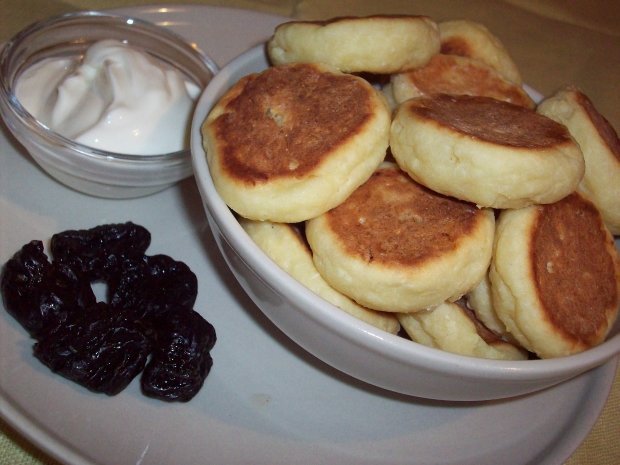
This method of preparing cheesecakes eliminates the presence of carcinogens
Curd jelly
Even those who don’t really like cottage cheese will enjoy this amazingly tasty dish.
Ingredients:
- cottage cheese 5% - 200 g;
- sugar - 0.5 cups or honey - 3-4 tbsp. l.;
- gelatin - 12 g;
- milk - 0.5 cups;
- sour cream - 125 g.
Add instant gelatin to the milk and leave to swell for 15–20 minutes. Combine cottage cheese, sugar and sour cream and beat the resulting mass with a blender until smooth.
Place the milk with the swollen gelatin in a water bath and, stirring constantly, melt the gelatin. After this, the gelatin mixture should be cooled to 40–50 °C and poured into the curd mass. Mix well, pour into bowls or glasses and set in the refrigerator for 40 minutes.
Calorie content of 100 g of product is 107.4 kcal.

Curd dessert can be decorated with nuts or berries
Fasting day
Sometimes during pregnancy, doctors prescribe fasting days. The need for this arises when a woman develops:
- swelling;
- excess body weight;
- rapid weight gain;
- high blood pressure;
- gestosis (late toxicosis).
During a fasting day, a pregnant woman can eat 600–700 g of cottage cheese with a fat content of no more than 5%, washing down each serving with 100 ml of kefir or natural yogurt. The entire volume of the product is divided into 6 doses. Between them you are allowed to drink 2 glasses of unsweetened tea.
Reviews
I know about these fasting days that: This is a unique list of cottage cheese 600 g low-fat, 60 g sour cream and 2 glasses of tea without sugar in 6 doses - minus 700 grams.
TinyKat
https://sibmama.ru/berem_rasgruz_dni.htm
Here is my fasting day - 1.5 liters of milk and 500 g of cottage cheese and that’s it, you can’t eat anything else, the effect is amazing. It’s very difficult to eat cottage cheese every two hours and wash it down with milk, but what can you do?
Lydia
https://sibmama.ru/berem_rasgruz_dni.htm
How to choose cottage cheese
You need to know some criteria to choose good cottage cheese for a nursing mother:
- the raw material for preparation is natural milk;
- the color is exclusively white, sometimes a little creamy (if the milk was very fatty);
- without bitterness and acid;
- specific but pleasant smell.
When purchasing in a store, you must carefully examine the packaging. There must be cottage cheese (not a curd product), without impurities, with a fresh shelf life (permissible period no more than 6-7 days), with the specified percentage of fat content. If the expiration date is more than a week, it means that it contains chemical additives and preservatives and should not be consumed. Stale cottage cheese has a yellowish color, is dry, and has an unpleasant sour-bitter odor.
It is necessary to exclude the consumption of curds and sweet cheeses due to the presence of chemical food additives, sugar and dyes in the form of various jams. If you really want curd mass, it is recommended to prepare it yourself by whipping cottage cheese with kefir and banana in a blender. If desired, you can add sugar or diversify with dried fruits.
It is better to purchase homemade cottage cheese when breastfeeding from those you know. There must be confidence that all hygienic standards for the production of the product are observed.
How to use cottage cheese during breastfeeding
To the question whether a nursing mother can have cottage cheese, there is a clear answer - of course, yes, but if there are no contraindications. Its use is even recommended. But if you don’t want to, you can replace it with another food containing a large amount of protein.
Komarovsky recommends using kefir and cottage cheese as the first complementary foods. Which once again shows how useful it is during breastfeeding for the body of the mother and baby; the baby will receive all the useful components contained in cottage cheese from breast milk.
It is not advisable to consume highly fatty milk, since the milk will be fatty, which will cause constipation in the baby. Low-fat will bring little benefit, since it is fats that promote calcium absorption. The optimal fat content of the product is 9%.
How to introduce it into the diet
The most common question among women is: how to use cottage cheese during lactation and how much cottage cheese a nursing mother needs.
You can use it in the first month if there is no contraindication. If breastfeeding, use daily. 150-170 g per day is enough. Start with a small amount (45-50 g) and observe the child’s reaction. As a rule, it appears in half a day. If there is no reaction, you should not increase the volume, limit yourself to the minimum norm for the first week, and only then gradually increase it to the daily volume.
If any manifestations of allergies appear in your baby, you should stop consuming it. You can try reintroduction after a few weeks. If colic or indigestion occurs, cottage cheese can be temporarily replaced with kefir or fermented baked milk.
You can eat cottage cheese with a variety of dried fruits and berries, but you just need to do it gradually and carefully. The main rule is not to mix all the components at once, introduce one at a time and watch the child’s reaction. If you eat everything at once, if your baby develops an allergy, it will be difficult to understand what exactly caused such a reaction.
Can a nursing mother have cottage cheese with sour cream?
Many people like to top it with sour cream and add sugar. When eating with sour cream, you should take into account that if the fat content of the cottage cheese is high and you also add sour cream, it can cause digestive upset in the baby. It is recommended to give priority to sour cream with a low fat content; it is advisable to use low-fat cottage cheese. You can use dried fruits instead of sugar. Just remember that prunes have a laxative effect. But dates will promote lactation, which is especially important during a lactation crisis. Raisins are rich in potassium and other microelements.
Morning or evening, whichever is better
If there are no health restrictions, cottage cheese can be consumed at any time of the day. Since it is rich in protein (casein is classified as a complex protein), which takes a long time to digest, it is perfect as a breakfast. Satiety occurs and hunger is not felt for the next few hours.
It is not recommended to eat a fatty product for dinner; the pancreas is overloaded. Since protein is absorbed for a long time, after having cottage cheese for dinner, you will not feel a strong feeling of hunger in the morning. In addition to burning calories during sleep, it increases energy expenditure during sleep. Studies have shown that consuming protein (casein) before bed increases resting energy expenditure. This fact speaks in favor of weight loss, which the mother so strives for after childbirth.
It also contains tryptophan, an amino acid that helps improve sleep and helps get rid of insomnia. Contains leucine, which is active in burning fat.
Based on these facts, we can come to the conclusion that you can consume cottage cheese during breastfeeding both in the morning and in the evening. The absorption of beneficial components occurs regardless of the time of consumption.
How to eat cottage cheese while breastfeeding
During breastfeeding, it is better to eat cottage cheese in compliance with certain standards:
- The daily intake of cottage cheese ranges from 160 to 300-400 g. It is better to replace the product from the store with freshly prepared one from whole milk;
- During lactation, avoid eating ready-made curd mass, chocolate cheesecakes and desserts that contain flavorings and fruit additives;
- Milk cannot replace cottage cheese in the diet;
- The shelf life of the finished product is short, so you should not buy it several days in advance;
- Cottage cheese should be included in the diet at 50 g per day. Preference is given to a product with a reduced fat content.
In order to make a tasty dish from unleavened cottage cheese, different recipes are used:
- Cottage cheese can be combined with cherries or other berries that do not cause allergic reactions. What cherries can you eat while breastfeeding? Preference is given to yellowish and red berries rather than dark burgundy ones. Cherries rarely cause allergies;
- In the first time after the baby is born, it is better for a nursing mother to exclude fried foods from her diet. After the baby turns three months old, pancakes with curd filling are allowed. The main thing is that they do not contain allergenic products;
- Cookies containing cottage cheese are healthier and tastier. It doesn't take much time to prepare it. Cookies with cottage cheese will turn out denser and more crumbly;
- Cottage cheese casserole with dried fruits is a great alternative to pancakes. Suitable fillers include dates, raisins, prunes and dried apricots.
A variety of cottage cheese dishes is a great way to avoid eating this product.
How to cook at home
There is nothing complicated about making homemade cottage cheese. Three liters of sour milk will yield 600-650 g of product.
- Milk may turn sour on its own. You can add sourdough, regular kefir or yogurt.
- Pour the sour milk into a container and heat it without bringing it to a boil.
- Once the flakes appear and the whey has separated, let cool slightly.
- Drain in a colander covered with cloth or gauze.
- After the whey has drained, hang it so that the liquid drains as much as possible.
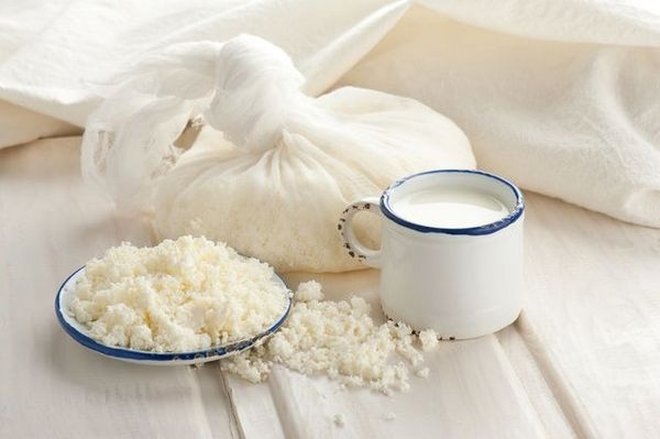
There is another cooking method:
- Heat three liters of boiled milk.
- Pour in a liter of kefir.
- Continue cooking without letting it boil for a couple of minutes.
- Cover and let cool.
- Drain in a colander with a cloth.
- Hang to drain all the liquid.
Dishes for mom
The most common dishes are cheesecakes, casseroles, pies (cheesecakes), dumplings. Let's take a closer look at healthy and less healthy dishes.
Casserole
Necessary:
- cottage cheese – 250 g;
- egg;
- semolina - a couple of spoons;
- a little salt;
- sugar – 45 g (can be replaced with banana).
Mix everything, place in a pre-greased mold and bake at 180°C for about half an hour. This is a universal recipe. You can, if desired, diversify with apples, raisins and other dried fruits. If you add pears, remember, they have a fixing effect.
Syrniki
Main components: cottage cheese, flour, eggs, sugar. The ingredients are fine, but the cooking technology is frying. It is better to start consuming fried foods after the third month of the baby’s life. There is a wonderful recipe for making cheesecakes in the oven.
Necessary:
- cottage cheese – 250 g;
- egg;
- salt;
- sugar – 35-45 g;
- semolina – 50-55 g;
- banana.
Mix all ingredients. Line a baking sheet with paper and grease with oil. Form cheesecakes and place on a baking sheet. Place a banana ring on top.
Casserole with rice
When eating this dish, you must remember that rice has a fixing effect.
Necessary:
- cottage cheese – 250 g;
- egg;
- a little salt;
- sugar – 45-55 g (can be replaced with banana);
- sour cream – 45 ml;
- rice – 100-120 g.
Preparation:
- cook rice;
- mix cottage cheese with sugar, egg, salt;
- add rice;
- Place in a greased container and bake at 180°C for a quarter of an hour.
Cooking methods
Cottage cheese with sour cream
Many women like to eat cottage cheese with sour cream and sugar. However, you should not get carried away with this method of preparation, since sour cream is a rather fatty product that can worsen the digestive process in a child.
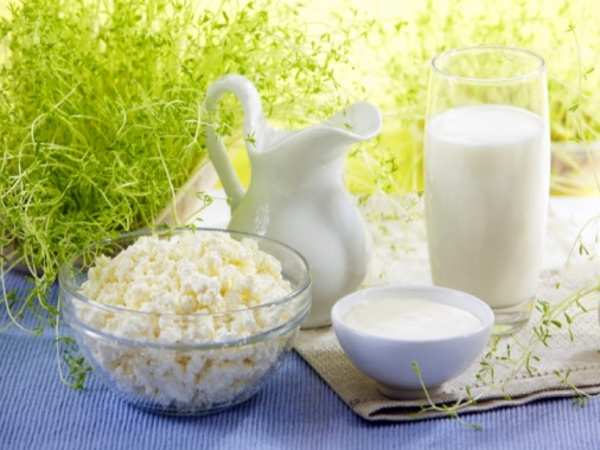
You can eat this curd mass in small quantities if you use low-fat sour cream. Also, such food contributes to the mental development of the baby. This product can only be consumed in the morning to reduce the activity of the child’s liver. The allowed amount of sour cream in the first month after childbirth is 1 teaspoon. And in the second month this volume can be increased to 2 spoons.
Cottage cheese in casserole form
The casserole is very useful during lactation, and it is also quick and easy to prepare. It is best to use the following recipe while breastfeeding.
Ingredients:
- cottage cheese 5-9%;
- 2 chicken eggs;
- 3 tbsp. l. semolina;
- if desired, you can add fruit that does not cause allergies in the child;
- a little sugar.
To prepare, you need to mix all the ingredients and place them on the mold. The prepared dish should be placed in the oven for half an hour. Before eating, nursing mothers are allowed to grease the casserole with a spoon of low-fat sour cream.
In the first month of a baby’s life, you should not eat such a dish every day, as this can lead to increased gas formation, colic and diarrhea in the baby . To avoid such consequences, it is necessary to gradually introduce casserole into the mother’s menu and constantly monitor the child’s well-being. You should also make a choice about what mom should eat – cottage cheese or casserole. It is not recommended to consume both dishes at the same time.
